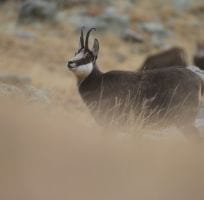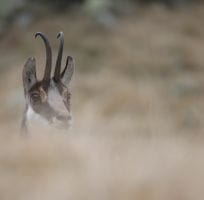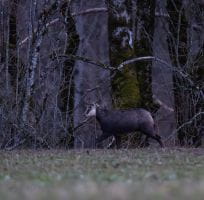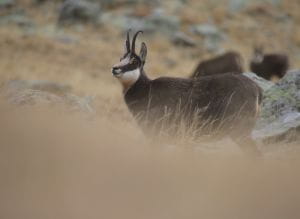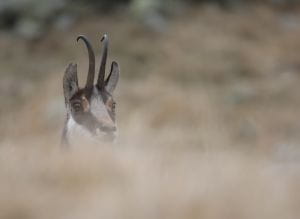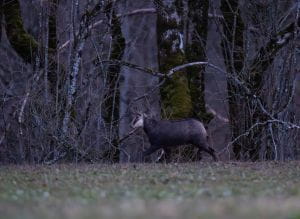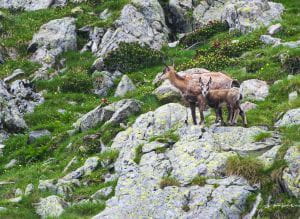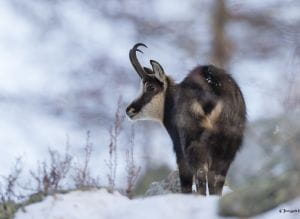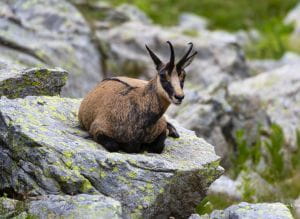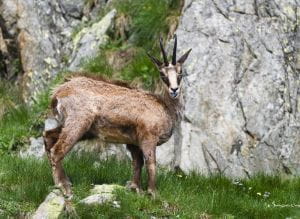A mountain athlete
An emblematic mountain animal, the chamois has significant numbers in the French Alps, where there are around 50,000 individuals. The Alpine national parks are home to 60% of national numbers (15,000 in the Écrins, 8,000 in the Mercantour and 6,000 in the Vanoise). In the Pyrenees, the smaller chamois is known as the Isard (Rupicapra rupicapra pyrenaica). They can also be found in the Cantal and Vosges regions, where they were reintroduced after disappearing at the beginning of the 20th century.
Chamois populations are larger in France than in Europe.
Chamois populations are higher in the heart of the National Park than in the surrounding area, where hunting is authorized but subject to a hunting plan.
84% of chamois in the Vanoise National Park are found in the core zone (source: www.parcsnationaux.fr).
On the Reserve, the population settled on the Col de Bleine has unfortunately been considerably reduced since 2010. Probably as a result of excessive hunting pressure, which forced us, in 2014, to set up quiet zones to encourage the return of this beautiful ungulate animal.
The chamois is fond of steep wooded areas but gains the foot of the southern slopes when the snow covers the heights because the chamois is not, as is often said, an exclusively mountain animal!
Did you know?
Chamois can climb 1,000 meters in a quarter of an hour (and even faster downhill)! A top athlete climbs the same difference in altitude in almost an hour! This is explained by the presence of a disproportionately large heart, which ensures a flow twice as great as in men.
An intense social life
The chamois is a gregarious animal living in matriarchal herds. Adult males may remain in these herds while others will isolate themselves. These herds develop social behaviors that are very interesting to study, the driving forces being rather young females.
The rut of the chamois begins in late October and lasts until early December. The males join the females and engage in “jousting”, usually visual. Each opponent seeks to impress the other with a set of threatening postures! Once his rivals are out of the way, one of the males groups the females in a restricted territory, which he watches from a high vantage point. When a female seems receptive, he approaches her with his head held high, pawing with his forelegs. At first, she seems paralyzed and then stands still. Often, to better slip away at the last moment, a final nose-thumbing before accepting mating!
In other words, the chamois is rather shy. Even if it is capable of peaceful cohabitation with other herbivores, it prefers to join territories neglected by other species.
The chamois is a rather shy animal.
Aside from man and disease, its main predators are eagles, wolves and lynx. Even if its running speed and living environment make it a difficult prey to catch.
These are the main predators.
Births in May or June
Gestation lasts 5 and a half months and life expectancy in the wild is between 15 and 20 years.
Females give birth, in May or June, to one calf, rarely two. The young goats, weighing in at 2.5 kg, are able to follow their mother a week after birth, even over steep terrain.
The goat kid is an alligator.
The kid is suckled for 4 to 5 months, but begins to diversify its diet from the third week, grazing on grass and licking stones (for mineral salts). He will live with the herd until he is at least 1 year old. More precisely, until it is rejected by its mother when she gives birth the following spring.
At one year of age, the young will put on a red coat and be named éterle for young females and éterlou for young males.
Mortality does not affect all age and sex classes equally. Survival rates are in the order of 50-60% for individuals under 1 year old, 60-80% for those aged 1-2 years, and almost 95% after 2 years. Survival is higher for females than for males. The two most important factors linked to chamois survival are winter weather conditions (length of snow cover) and predation.
Did you know?
In zoology, parental care refers to all the behaviors involved in raising, protecting and feeding young. In mammals, it’s the females who practice parental care in 95% of known species (“The Evolution of Parental Care” T. H. Clutton-Brock, 1991), and no known mammal practices coparental care, however widespread among birds!
The evolutionary history of the Chamois
During the 19th and 20th centuries, all over Europe, mankind urbanized more and more territories, occupied more and more wild spaces and unfortunately destroyed many natural habitats.
Initially present in low-altitude mixed or coniferous forests, the chamois has slowly migrated to high-altitude areas where it was no longer competing with grassland species, themselves pushed back by man into these same forests.
The chamois has had to adapt to the rock faces and escarpments where it is present today.
In summer, it can be found above the tree line, in the alpine and subalpine levels. In winter, it descends into the montane levels, and even in some European mountains, into the hilly level.
